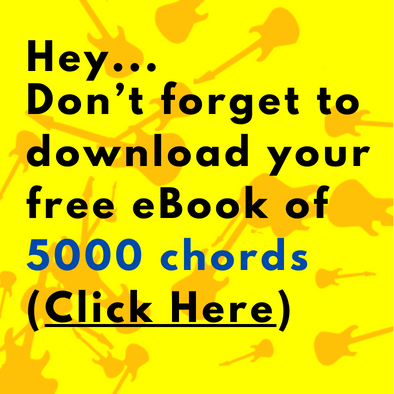The Eb Major chord is one of the most common and popular chords on the guitar. The open Eb chord is one of the first chords that most guitarists learn, and it has been used in countless songs across many genres.
Some Quick E Flat Chord Theory
- The Eb Major chord contains the notes Eb, G and Bb.
- The Eb Major chord is produced by playing the 1st (root), 3rd and 5th notes of the E Flat Major scale.
- The Eb Major chord (just like all Major chords) contains the following intervals (from the root note): Major 3rd, minor 3rd, Perfect 4th (back to the root note).
- The Eb Major chord is the first chord in the key of Eb Major. The seven chords in the key of E flat Major are: Eb, Fm, Gm, Ab, Bb, Cm, D diminished.
10 Ways To Play The Eb Major Chord
If you’ve come to this page just to view some chord diagrams for Eb, here they are.

Standard Eb Chord Shape
The most common way to play the Eb chord essentially the root-5 Eb barre chord, played on the sixth fret. Often, as in the example below, the first finger does not actually form a barre, but instead simply plays the root note.

Easy Eb Chord Shape
The easy version of the Eb chord is played on the first three strings of the guitar. Learning this simplified shape can be a good way to start using the Eb chord if you find the barre chord versions too challenging. It is the same shape as the standard open D chord shape (without the open string) and moved up one fret.

How to Play the E Flat Major Chord (Step by Step)
- Place your first finger on the sixth fret of the fifth string.
- Place your second finger on the eighth fret of the fourth string.
- Place your third finger on the eighth fret of the third string.
- Place your fourth finger on the eighth fret of the second string.
- Without strumming the sixth string, strum the first five strings.
The instructions above are step by step instructions for playing the most common Eb Major chord shape. These instructions can actually be super helpful when you feel like you’re interpreting the shape incorrectly. By going through the Eb chord instructions step by step, you can verify that you’re playing the chord correctly.
Barre Chord Shapes for E Flat
The Eb chord can be played as a barre chord by playing a root 6 barre chord shape and starting on the 11th fret or by playing a root 5 barre chord Major shape and starting on the 6th fret:

Eb Major Triads
Playing the Eb chord using barre chord shapes is the most common way of playing the chord. However, it is also useful to explore the chord using triads (including inversions). The E flat Major triad can be voiced in the following three ways:
- Eb Major Triad (Root Position) – Eb, G, Bb
- Eb Major Triad (1st Inversion) – G, Bb, Eb
- Eb Major Triad (2nd Inversion) – Bb, Eb, G
Here are six different ways to play the Eb Major triad (including inversions).

Which Keys Have The Eb chord in Them?
The Eb chord can be found in the following keys:
- The key of Eb Major (Eb, Fm, Gm, Ab, Bb, Cm, Ddim)
- The key of Bb Major (Bb, Cm, Dm, Eb, F, Gm, Adim)
- The key of Ab Major (Ab, Bbm, Cm, Db, Eb, Fm, Gdim)
- The key of C minor (Cm, Ddim, Eb, Fm, Gm, Ab, Bb)
- The key of G minor (Gm, Adim, Bb, Cm, Dm, Eb, F)
- The key of F minor (Fm, Gdim, Ab, Bbm, Cm, Db, Eb)
Alternative But Useful E Flat Chord Shapes
The following shapes are alternative ways of playing the E flat Major chord shape. They’re not the most common Eb shapes, but used enough to include here as interesting alternatives.

Eb Chord Substitutions
The Eb chord can often be substituted with the Eb sus 4 chord, the Eb sus 2 chord and the Eb add 9 chord. The Eb chord can also be used itself as a substitute for more complicated chords, such as the Eb Major 7 chord, the Eb7 chord, and other extension chords which have Eb as the root note (it can’t be used in place of minor chords though!).
Which Scales Can Be Played Over the Eb chord?
The most common and effective scales that can be used to solo/improvise over the Eb Major chord, or to create melodies for the purposes of song writing are:
- Eb Major pentatonic scale – This scale will almost always work over the Eb Major chord, in any context.
- Eb Major scale – This is the ‘default scale’ of the Eb chord.
- Eb Lydian mode – This scale can be used over the Eb chord in certain contexts to add a jazz flavour.
- Eb Major Blues – This scale is particularly useful in a Blues context.
